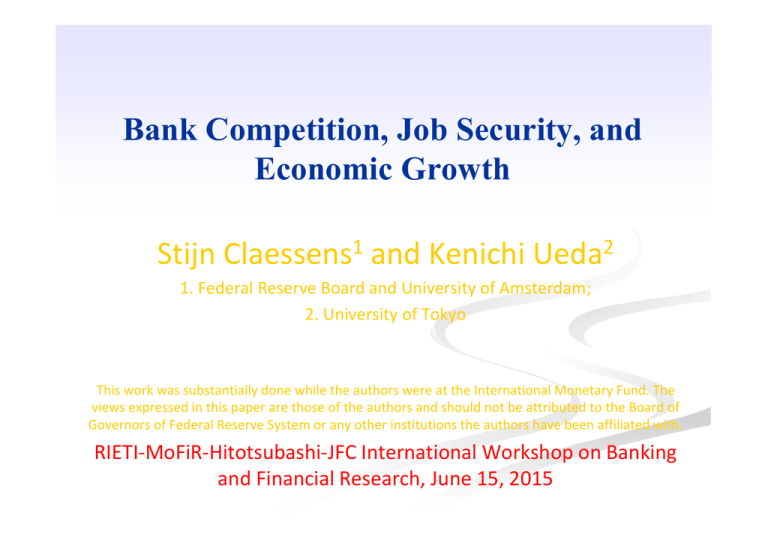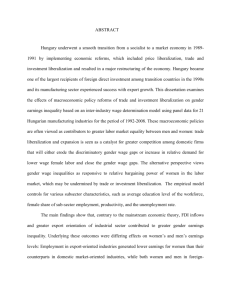Bank Competition, Job Security, and Economic Growth Stijn Claessens and Kenichi Ueda
advertisement

Bank Competition, Job Security, and Economic Growth Stijn Claessens1 and Kenichi Ueda2 1. Federal Reserve Board and University of Amsterdam; 2. University of Tokyo This work was substantially done while the authors were at the International Monetary Fund. The views expressed in this paper are those of the authors and should not be attributed to the Board of Governors of Federal Reserve System or any other institutions the authors have been affiliated with. RIETI‐MoFiR‐Hitotsubashi‐JFC International Workshop on Banking and Financial Research, June 15, 2015 Overview Identify a new channel through which banks affect the economy. Bank’s monopolistic power influences job security, which then enhance or reduce productivity, depending on industries. Develop a simple theory, extending the hold-up problem associated with firm-specific investment to include bank influence on worker layoff. Test and confirm our theoretical predictions based on panel regressions utilizing a natural experiment in U.S. 1970s-90s (financial liberalization and employment protection). Implication: Separately studying labor protection and financial liberalization shows an incomplete picture. 2 Quick literature review Financial liberalization and resulting bank competition is often shown theoretically and empirically as bringing positive effects on efficiency (many papers). Neoclassical theory suggests any labor protection bring efficiency loss. Hopenhayn and Rogerson 1993, Bertola 1994, Parente and Prescott 2000. Empirical study usually supports this view. Scarpetta and Tresse 2004, Cingano et al. 2010, Botero et al. 2004. 3 Quick literature review Positive theoretical effects of labor protection as it increases firm-specific investment by workers. Murphy 1986, Saint-Paul 1996, Takizawa 2003. variant: Blanchard and Tirole 2008 Alignment of bargaining power matters. Hart 1995, Caballero and Hammour 1998, Allen, Carletti, and Marquez, 2007 Negative empirical results for labor protection even jointly considering finance side. Fonseca and Utero 2007, Pagano and Volpin 2005 Complex schemes of bank loan repayments by distressed firms Townsend and Yaron, 2001. 4 Theoretical predictions and empirical results For industries not depending so much on human capital, employment protection is distortionary. Standard theoretical prediction of labor literature. Many confirm this empirically, and so do we. Productivity gains should be observed with basic employment protection in industries using human capital intensively. This theoretical prediction is not new in the literature. Few empirically confirm this previously, but we find this effect. Most importantly, such gains from job security should be influenced by the bank monopolistic powers. Theoretically new. Empirically new, too, and we confirm this. 5 U.S. Reforms as Natural Experiment We use state-by state reforms for 1970s – 1990s: financial liberalization (bank branch deregulation) and employment protection (exemptions for wrongful discharges) . Bank branch was not allowed before (unit banking). Within the same state, gradually, branches based on M&A, and then de novo branches were allowed. (Federal-level liberalization after 1994.) Before, “you’re fired” was immediately implemented. Several exemptions have been added gradually: public policy, good faith, and implied contract. 6 7 8 Specific literature US bank branch deregulation---positive effects Jayaratne and Strahan 1996, and many by Strahan US employment protection---zero or negative effects Dertouzos and Karoly, 1992, 1993, Miles 2000, Autor, Donohue, and Schwab 2006, Autor, Kerr, and Kugler 2007. 9 Econometric Methodology Dependent variable is growth in state or state-industry value-added over 1973 to 1994 State level regressions: 10 State-level regression (real GSP growth) • Similar results for other WorkRight and with non-financial GDP 11 State-industry level growth regression g j,s,t s, j s,t FinLibs,t1 * ExtFinDep j WorkRight s,t1 * KnowledgeDep j 1FinLibs,t1 *WorkRight s,t1 * ExtFinDep j 2 FinLibs,t1 *WorkRight s,t1 * KnowledgeDep j j,s,t . 12 State-industry level real growth regressions 13 …continued 14 Robustness Ending earlier (1990) or later (1997); Starting 1983. Endogeneity: external dependence or knowledge intensity drives liberalization or employment protection? Already dropped special finance states (DE and SD). Dropping MA and CA (special, “high tech” states) and NY does not change the results. Panel GMM with AR(1) and AR(2): results hold broadly, if not stronger (esp. Schooling), though “goodness of fit” is low and so GMM seems not necessary 15 Panel GMM 16 …continued 17 US-wide Average of State-Specific Minimum Wage and Union Coverage 18" 8" 16" 7" 14" 6" 12" 5" 10" 4" 8" Minimum"Wage"(USD"CPI"adjusted,"leB"scale)" 3" 6" 2" 1972" 1973" 1974" 1975" 1976" 1977" 1978" 1979" 1980" 1981" 1982" 1983" 1984" 1985" 1986" 1987" 1988" 1989" 1990" 1991" 1992" 1993" Union"Coverage"(%,"right"scale)" 4" Note: “right-to-work states have lower unemployment rates and faster job growth, but also lower wages” WSJ 12/17/2012. 18 Union and Minimum Wage (1983-1993) as WorkRight measures 19 Empirical study summary Exemption for wrongful discharge is likely basic labor protection, which can enhance efficiency. Especially, our regression results suggest stakeholders’ relative bargaining powers matter, in particular for knowledge-intensive and external-finance dependent industries. Existing literature and our regressions on union and minimum wage imply non-equilibrium high wage or too generous labor protection is detrimental to economic growth. 20 Theoretical question Firm-specific investments may increase due to stronger job security by mitigating the hold-up problem. However, given bank’s involvement in distressed firms, worker layoff should be affected by bank’s relative bargaining power. Can we write a theoretical model? Need debt contract with possible default CSV (Townsend 79) Need fixed wage contract with possible layoff CSV Low revenue default vs layoff (costly) negotiation necessary 21 Theory: model setup—time line 1. A firm hires lˆ workers for efficiency wage w and borrows k capital at r from a bank. (Bank capital endowment k; labor endowment 1.) 2. Workers invest in firm-specific human capital h. 3. Signal ρ (from pdf f) about the productivity shock θ; simply ρ=θ. 4. If low signal is reported, the bank and workers verify the state and negotiate (with cost τ) about layoff or default or both. The firm may fire (lˆ l) workers (but cannot hire workers with h=0). 5. 6. Wage cut negotiation with all workers is costlier than layoff of subset of workers. Production y k1 (hl) at firm. Or, low-skill work bl. A worker receives either wh or b. The bank receives either rk or y-whl. Household utility u(c) – v(h). 22 Solving backward (5,4) 5: Given l, h, k and w, r, unique threshold of shock for default, * g(k,h,l;r,w) 4: If rk whl k1 (hl) then (all kept employed). Otherwise, lay off workers to the ex post efficient level k l ( ) h w * 1 1 Actual l is determined by bargaining with worker power λ: l (1 )l * ( ) lˆ 23 Solving backward (3,2) 2: Worker decide firm-specific human capital investment, considering the employment probability given average h: e l / lˆ * max 1 F( ) u(wh) ef ( )d u(wh ) h * * (1 e) f ( )d u(b ) v(h) FOC Unique h*, equal to average h in eq.: (assuming small τ) * * v'(h) 1 F( ) ef ( )d u '(wh)w For the sake of simplicity, no externality through average h (in e) is assumed. h* turns out increasing in λ; but decreasing in w with small τ. 24 Solving backward (1) 1. First period employment and capital input decision - firm manager borrowing from banks and employing labor max ˆ k,l *( lˆ ) k1 (h*l) wh*lˆ rk f ( )d - subject to bank’s arbitrage free condition with risk free rate rF k rkf ( )d ˆ *( l ) *( lˆ ) 1 * * k (h l ) wh l f ( )d - Together firm value maximization problem 25 Solving backward (1) FOC w.r.t. initial labor 1 * * MPL1 w f ( )d 2 MPL2 w f ( )d 0 where -If λ=0, for each bad signal ρ, MPL2 =w, implying that labor demand -Together -As , with inelastic labor supply, the equilibrium wage is determined, w0. , so - Together with inelastic labor supply, the equilibrium wage is determined, w1. 26 General Equilibrium For general λ, the labor demand curve from the FOC can be shown as downward sloping. Together with inelastic labor supply the equilibrium wage is determined at wλ. Similarly, given rF, the bank arbitrage condition provides the downward sloping capital demand. Together with initial capital endowment (supply), the equilibrium interest is determined at rλ. rF undetermined but needs to be in the vicinity of the first best MPk. 27 Time Inconsistency Problem Suppose a firm can commit to specific λ. FOC w.r.t. λ is - λ=0 and 1 are two corner solutions. However, there can be an internal solution λ* that satisfies - It maximizes profits: inverse-U shape profit function around λ*. 28 Time Inconsistency Problem There is an optimal level of λ* between zero and one for a firm. Ranking on multiple eq. is difficult. Still, the corner solutions are not likely the best, as long as the trade-off between human capital investment and flexible firing is important. However, without a commitment technology, a firm ends up firing workers ex post as much as possible, i.e., λ=0. Basic employment protection by law is then beneficial as the commitment device for firms. But, too generous worker protection makes λ on the right side of the peak. 29 Social optimal (assuming income sharing) Socially destructing firing or retention can happen, depending on the productivity shock. Let tilde ρ denote that threshold. The expected loss from the socially destructive firing is, The opposite case is the socially destructive retention, which brings the expected loss Net social loss is the sum of the two. The social planner’s first order condition is the firm’s FOC minus this net social loss. 30 Social optimal Among λ that satisfy the firm FOC, λ=0 and 1 cannot be social optimum because they cannot make the net social loss to be zero. λ=1 creates positive socially destructive retention λ=0 creates positive socially destructive firing In general, privately optimal λ* does not guarantee zero net social loss. However, it could coincide to the one producing zero net social loss. (And, in this case, it is socially optimal.) Additional argument for some legal restrictions on firing but the direction is uncertain. 31 Conclusion Develop a simple new model that endogenizes the degree of the hold-up problem between workers, which invest in firm-specific human capital, and firms, which become increasingly representing creditor interests in distress. Show that the model predictions are consistent with empirical patterns in the U.S. Point out importance of basic labor protection, while showing generous protection is detrimental to growth. 32






